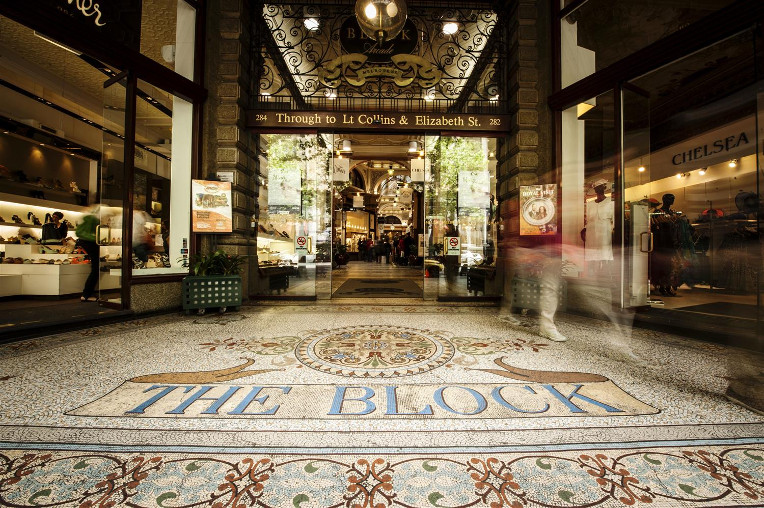Difference between revisions of "Block Arcade"
(→The Arcade's Dark History) |
|||
| (20 intermediate revisions by the same user not shown) | |||
| Line 1: | Line 1: | ||
;[[Melbourne]] | ;[[Melbourne]] | ||
| − | [[]] | + | [[File:Block Arcade entrance night.jpg]] |
<br> | <br> | ||
<br> | <br> | ||
| − | == | + | == The Block Arcade: Introduction == |
| − | The Block Arcade is | + | The Block Arcade (280-286 Collins Street) is arguably the most beautiful of Melbourne's historical and architectural treasures. The Collins Street wing of the arcade dates back to 1892 and the Elizabeth Street wing to 1893. The arcade was developed by the infamous financier, Benjamin Fink, of the City Property Company during Melbourne's glorious boom-time. The architect was David C. Askew and the design was inspired by the Galleria Vittorio Emanuele in Milan, Italy. |
| − | + | <br> | |
| − | + | <br> | |
| − | + | [[File:Block Arcade interior1.jpg]] | |
| − | The | + | <br> |
| − | + | <br> | |
| − | + | At ground level, the Block Arcade showcases beautiful boutiques selling jewellery, watches, shirts, shoes, and chocolate. This has always been a fashionable place to shop, to see and be seen. The levels above are mainly used as offices. | |
| − | + | <br> | |
| − | + | <br> | |
| − | + | [[File:Block Arcade interior2.jpg]] | |
| − | + | <br> | |
| − | + | <br> | |
| − | + | The Block Arcade features lavish interior decoration, a beautiful glass dome, and an intricate mosaic tiled floor. The mosaic floor was designed by the UK company Craven Dunnell and each tile was imported from Italy. In fact, the Block Arcade still holds in reserve samples of all colours used, except for dark chocolate. The Building and Engineering Journal noted that this was the largest expanse of mosaic to be laid down in Australia at the time. | |
| − | + | <br> | |
| + | <br> | ||
| + | [[File:Block Arcade mosaic floor.JPG]] | ||
| + | <br> | ||
| + | <br> | ||
| + | Below you can see the Collins Street and Elizabeth Street facades of the Block Arcade respectively. These are extraordinary examples of the Victorian style of Mannerism. Significant features include lower-level rustication and triangular pediments. | ||
| + | <br> | ||
| + | <br> | ||
| + | [[File:Block Arcade Collins Street Facade.JPG]] | ||
| + | <br> | ||
| + | <br> | ||
| + | [[File:Block Arcade Elizabeth Street Facade.JPG]] | ||
| + | <br> | ||
| + | <br> | ||
| + | There is no doubt that the Block Arcade enjoys a long and rich history. However, the site of the arcade dates back even further. | ||
== <span style="color:#800000;"> The Arcade's Dark History == | == <span style="color:#800000;"> The Arcade's Dark History == | ||
| + | [[File:Block Arcade 1908.jpg]] | ||
| + | <br> | ||
| + | <br> | ||
<span style="color:#800000;">''The larrikin tradition plays strongly amid the Kindred courts of Melbourne, where rebellion is ingrained in the Australian character as a result of British imperialism: Almost a century ago, the Barcade Boys, a | <span style="color:#800000;">''The larrikin tradition plays strongly amid the Kindred courts of Melbourne, where rebellion is ingrained in the Australian character as a result of British imperialism: Almost a century ago, the Barcade Boys, a | ||
youth gang of pimps and drug pushers, infested the Block Arcade. Out of place in the splendid Victorian style of the arcade, the gutter gang nonetheless ran their rackets with seeming impunity.'' | youth gang of pimps and drug pushers, infested the Block Arcade. Out of place in the splendid Victorian style of the arcade, the gutter gang nonetheless ran their rackets with seeming impunity.'' | ||
| Line 25: | Line 42: | ||
<span style="color:#800000;">''And impunity they had, as their shadow patron, a Malkavian claiming to be the childe of Sydney’s Prince Sarrasine, had brought the proprietors of the Block Arcade under her sway. At the same time, | <span style="color:#800000;">''And impunity they had, as their shadow patron, a Malkavian claiming to be the childe of Sydney’s Prince Sarrasine, had brought the proprietors of the Block Arcade under her sway. At the same time, | ||
the Malkavian courted the support of Melbourne’s then-Prince Montague Lytton — keeping each of the Princes ignorant of her involvement with the other.'' | the Malkavian courted the support of Melbourne’s then-Prince Montague Lytton — keeping each of the Princes ignorant of her involvement with the other.'' | ||
| − | + | <br> | |
| + | <br> | ||
| + | [[File:Block Arcade 1900s.jpg]] | ||
| + | <br> | ||
| + | <br> | ||
<span style="color:#800000;">''Such a ruse could work for only so long, and when Sarrasine learned that he was being played against Lytton, his ghouls lashed out with a desire to cause a panic in Melbourne and make its Kindred feel | <span style="color:#800000;">''Such a ruse could work for only so long, and when Sarrasine learned that he was being played against Lytton, his ghouls lashed out with a desire to cause a panic in Melbourne and make its Kindred feel | ||
Sarrasine’s supremacy. In 1891, they stormed the Block Arcade by day, scattering the Barcade Boys, and hopefully breaking the Malkavian’s sway over what she had treated as her entitled domain.'' | Sarrasine’s supremacy. In 1891, they stormed the Block Arcade by day, scattering the Barcade Boys, and hopefully breaking the Malkavian’s sway over what she had treated as her entitled domain.'' | ||
| Line 31: | Line 52: | ||
<span style="color:#800000;">''The next night, however, the Malkavian had her revenge. She sent a plague of wraiths to settle the score — a trio of ghostly firefighters who had lost their lives a few years earlier in the | <span style="color:#800000;">''The next night, however, the Malkavian had her revenge. She sent a plague of wraiths to settle the score — a trio of ghostly firefighters who had lost their lives a few years earlier in the | ||
Georges department store fire (which had, not coincidentally, also started under bizarre circumstances). Sarrasine’s ghoul agents met their end and the Prince of Sydney was rebuffed, in another turn of the Jyhad’s events.'' | Georges department store fire (which had, not coincidentally, also started under bizarre circumstances). Sarrasine’s ghoul agents met their end and the Prince of Sydney was rebuffed, in another turn of the Jyhad’s events.'' | ||
| − | + | <br> | |
| + | <br> | ||
| + | [[File:Block Arcade shop interior 1900.jpg]] | ||
| + | <br> | ||
| + | <br> | ||
<span style="color:#800000;">''Just who this Malkavian childe of a Setite Prince is remains unsolved, however. She claims the Block Arcade as her domain to this night, over a century after its original construction, having survived multiple | <span style="color:#800000;">''Just who this Malkavian childe of a Setite Prince is remains unsolved, however. She claims the Block Arcade as her domain to this night, over a century after its original construction, having survived multiple | ||
Princes of Melbourne and the enmity of the Prince of Sydney. And just how is that she was able to manipulate the shades of the departed firefighters? The Kindred of Melbourne, many of whom are Anarchs (despite Prince Taylor’s suppression of Brujah other than himself), prefer not to entertain such questions.'' | Princes of Melbourne and the enmity of the Prince of Sydney. And just how is that she was able to manipulate the shades of the departed firefighters? The Kindred of Melbourne, many of whom are Anarchs (despite Prince Taylor’s suppression of Brujah other than himself), prefer not to entertain such questions.'' | ||
| Line 39: | Line 64: | ||
http://theblock.com.au/ | http://theblock.com.au/ | ||
| + | |||
| + | http://melbournecurious.blogspot.com/2010/07/block-arcade-introduction.html | ||
Latest revision as of 12:48, 6 March 2016
The Block Arcade: Introduction
The Block Arcade (280-286 Collins Street) is arguably the most beautiful of Melbourne's historical and architectural treasures. The Collins Street wing of the arcade dates back to 1892 and the Elizabeth Street wing to 1893. The arcade was developed by the infamous financier, Benjamin Fink, of the City Property Company during Melbourne's glorious boom-time. The architect was David C. Askew and the design was inspired by the Galleria Vittorio Emanuele in Milan, Italy.
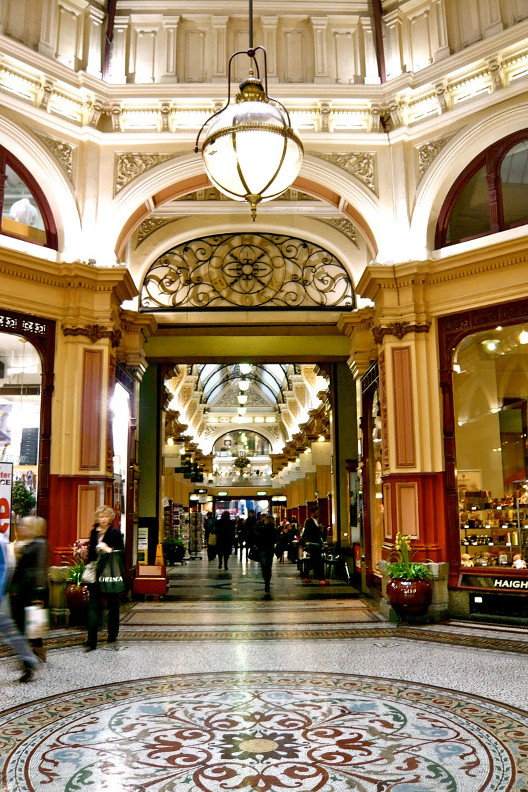
At ground level, the Block Arcade showcases beautiful boutiques selling jewellery, watches, shirts, shoes, and chocolate. This has always been a fashionable place to shop, to see and be seen. The levels above are mainly used as offices.
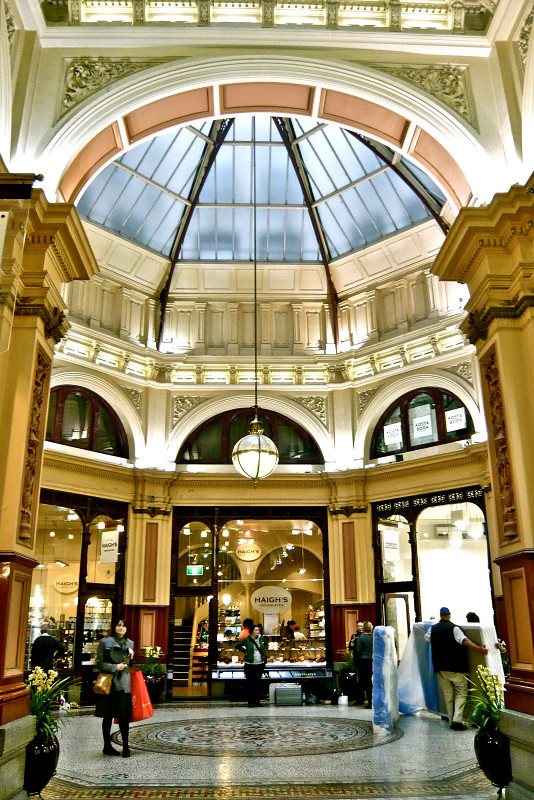
The Block Arcade features lavish interior decoration, a beautiful glass dome, and an intricate mosaic tiled floor. The mosaic floor was designed by the UK company Craven Dunnell and each tile was imported from Italy. In fact, the Block Arcade still holds in reserve samples of all colours used, except for dark chocolate. The Building and Engineering Journal noted that this was the largest expanse of mosaic to be laid down in Australia at the time.
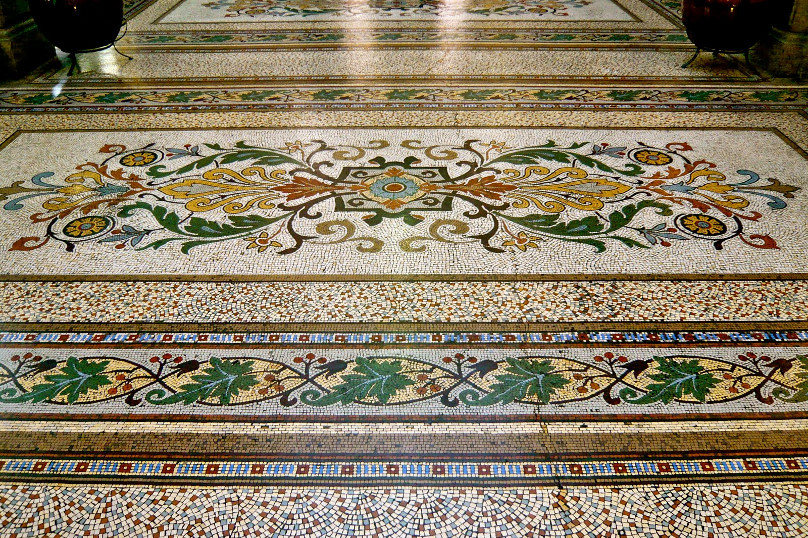
Below you can see the Collins Street and Elizabeth Street facades of the Block Arcade respectively. These are extraordinary examples of the Victorian style of Mannerism. Significant features include lower-level rustication and triangular pediments.
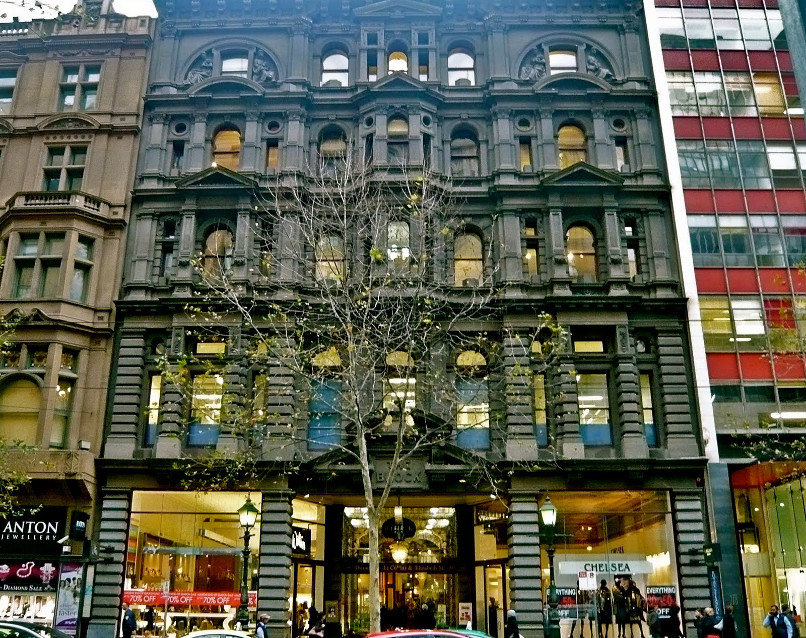
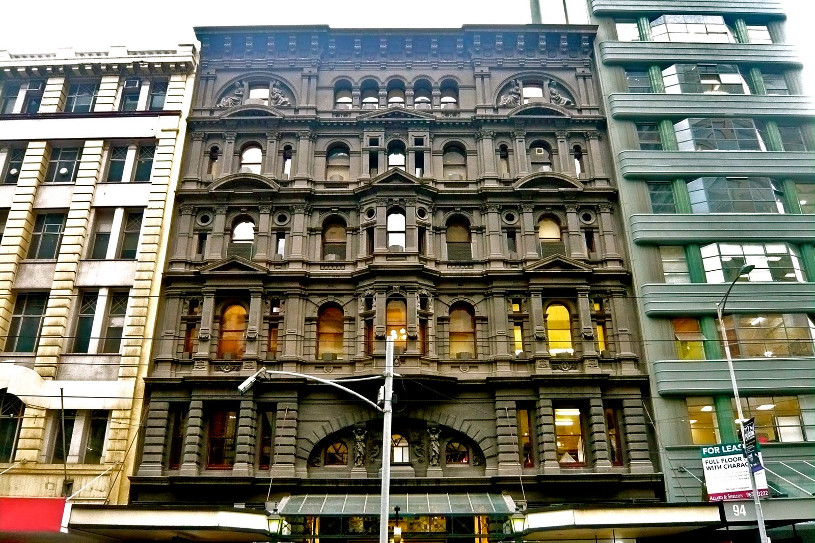
There is no doubt that the Block Arcade enjoys a long and rich history. However, the site of the arcade dates back even further.
The Arcade's Dark History
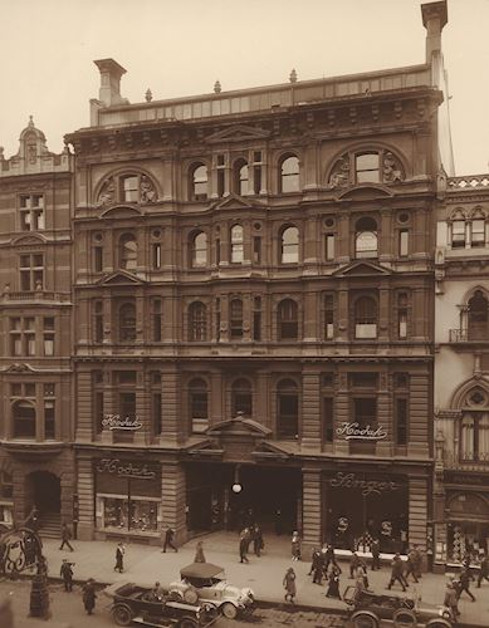
The larrikin tradition plays strongly amid the Kindred courts of Melbourne, where rebellion is ingrained in the Australian character as a result of British imperialism: Almost a century ago, the Barcade Boys, a
youth gang of pimps and drug pushers, infested the Block Arcade. Out of place in the splendid Victorian style of the arcade, the gutter gang nonetheless ran their rackets with seeming impunity.
And impunity they had, as their shadow patron, a Malkavian claiming to be the childe of Sydney’s Prince Sarrasine, had brought the proprietors of the Block Arcade under her sway. At the same time,
the Malkavian courted the support of Melbourne’s then-Prince Montague Lytton — keeping each of the Princes ignorant of her involvement with the other.
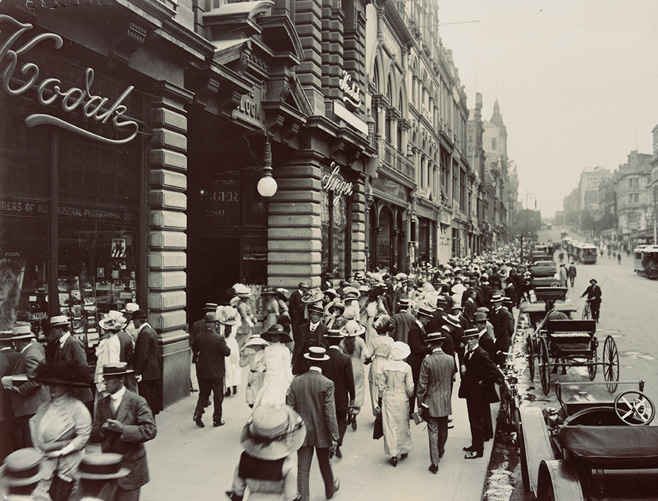
Such a ruse could work for only so long, and when Sarrasine learned that he was being played against Lytton, his ghouls lashed out with a desire to cause a panic in Melbourne and make its Kindred feel
Sarrasine’s supremacy. In 1891, they stormed the Block Arcade by day, scattering the Barcade Boys, and hopefully breaking the Malkavian’s sway over what she had treated as her entitled domain.
The next night, however, the Malkavian had her revenge. She sent a plague of wraiths to settle the score — a trio of ghostly firefighters who had lost their lives a few years earlier in the
Georges department store fire (which had, not coincidentally, also started under bizarre circumstances). Sarrasine’s ghoul agents met their end and the Prince of Sydney was rebuffed, in another turn of the Jyhad’s events.
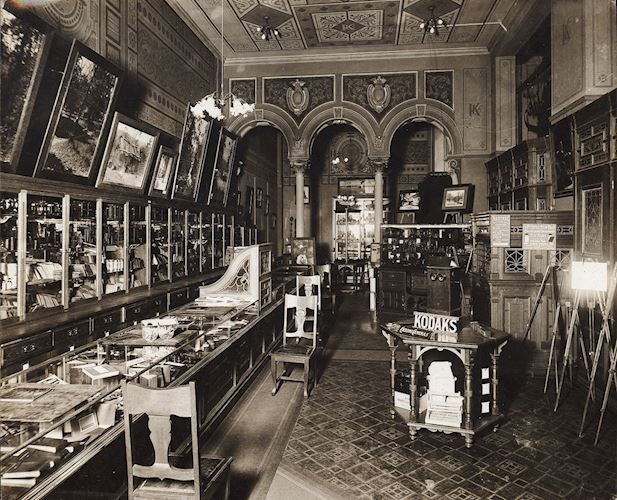
Just who this Malkavian childe of a Setite Prince is remains unsolved, however. She claims the Block Arcade as her domain to this night, over a century after its original construction, having survived multiple
Princes of Melbourne and the enmity of the Prince of Sydney. And just how is that she was able to manipulate the shades of the departed firefighters? The Kindred of Melbourne, many of whom are Anarchs (despite Prince Taylor’s suppression of Brujah other than himself), prefer not to entertain such questions.
https://en.wikipedia.org/wiki/Block_Arcade,_Melbourne
http://melbournecurious.blogspot.com/2010/07/block-arcade-introduction.html
